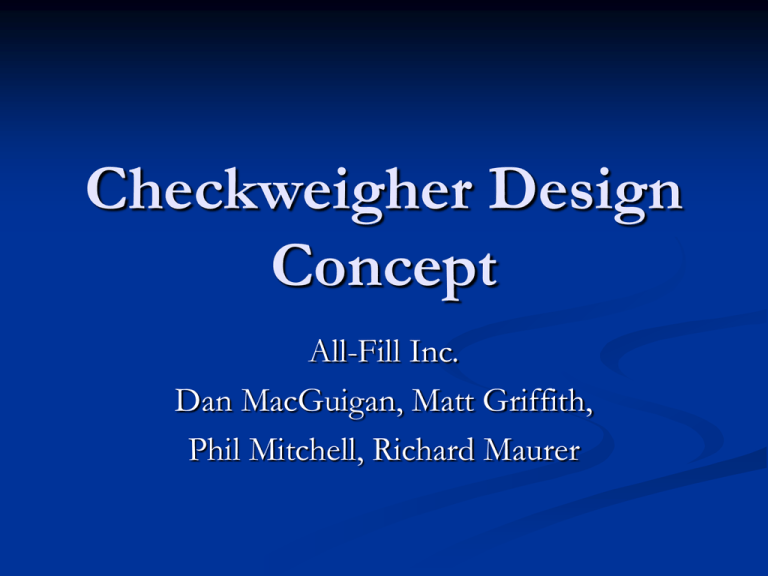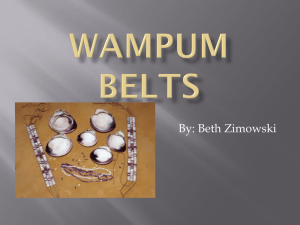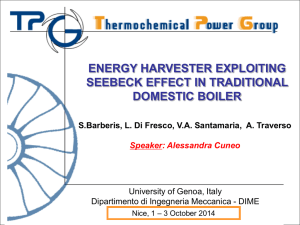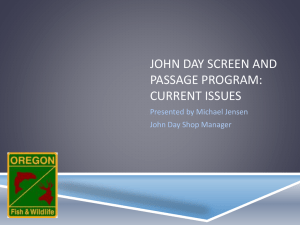14.6
advertisement

Checkweigher Design Concept All-Fill Inc. Dan MacGuigan, Matt Griffith, Phil Mitchell, Richard Maurer Introduction of Project • Weighs Products • Rejects out-of-spec Products • Quality Control •Up to 200 products/min. Improvement Objectives (Wants) Decrease Cost Material Manufacturing/Machining Time Assembly Time Fewer Parts Fewer Required Tools Increase Marketability Easier Maintenance “Tool-less” Belt Changes Drive Belt Conveyor Belt Faster Order Turnaround Design Constraints Safety Protection From Moving Parts Design Against Catastrophic Failure Weight Footprint Cannot Increase Overall Weight Cannot Change Current Footprint Life Service Life Cannot Decrease Improvement Metrics Metric Material Cost Current Target Achieved $290/$740 $230/$590 $220/$184 Manufacturing Time 18.5 hrs 14 hrs 10 hrs Assembly Time 17 min 14 min 14 min Number of Parts 86/208 75/100 80/99 1 2 2 3 0 0 # of Rollers # of Tools Required for Belt Change How to Meet Wants Divide Checkweigher into Subsystems Each Subsystem Offers Benefits Some Subsystems Interrelated Compounded Improvements Identification of Subsystems Motor Mount Roller Attachment Knife-Edge Sidebars & Tie Bars Current Design Motor Mount Wants Lower Cost (Benefits Sponsor) Fewer Small Parts (Nuts, Washers, etc.) Less Costly Manufacturing Faster Assembly Increase Marketability (Benefits Customer) Easy Tensioning of Timing Belt “Tool-less” / Fast Belt Change Metric Curren Target t Time to Change Belt 7.3 min 5 min 3.3 min 2 min 1 min 0.5 min # of Tools to Change Belt 3 0 0 Number of Parts 6 5 4 Time to Properly Tension belt Achieved Motor Mount - Current Motor Mount - New Thumb Screw Wants Lower Cost (Benefits Sponsor) Roller Integration Lower Manufacturing Cost Increased Marketability (Benefits Customer) “Tool-less” Belt Change More Versatile Metric Curren Target Achieved t Time to Assemble 17 min 13 min 14 min # of Rollers Types 1 2 2 # of Tools to Change Belt 3 0 0 Roller Integration – Current Roller Attachment Current Attachment Points of Rollers Points Roller Integration – New End Caps Drive End Cap Knife-Edge End Cap Conventional Idler End Cap End Cap Integration Snap Ring and Pliers Concept Roller Attachment Points Cotter Pin Knife-Edge Wants Lower Cost (Benefits Sponsor) Lower Cost Simpler Increased Marketability (Benefits Customer) Less Vibration Less Belt Wear Shorter Transition Distance Metric Curren Target Achieved t Time to Manufacture 7 hr 5 hr 3.7 hr Material Cost $740 $590 $184 # of Parts 208 100 99 Knife-Edge - Current Nylon Spacer Bearing Problems Many Small Parts Expensive Difficult to Assemble Knife-Edge - New Material – PTFE (Teflon®) Low Coefficient of Friction High Melting Temperature Inexpensive Few Parts Sidebars & Tie Bars Wants Lower Cost (Benefits Sponsor) Lower Material Cost Shorter Manufacturing Time End Cap Integration Increased Marketability (Benefits Customer) FDA Approved Lighter Metric Material Cost (per pair) Mass/Length FDA Approved Current Target Achieved $20 $10 $6 0.05 lbm/in 0.03 lbm/in 0.03 lbm/in Yes Yes Available Sidebars - New Polycarbonate Lighter Less Expensive Easily Machined Sufficient Mechanical Properties FDA Approved Available End Cap Integration Tie Bars - New Redesigned for Compatibility with Polycarbonate Sidebars Single Attachment to Sidebar Material Change From Aluminum to Polycarbonate Less Costly Lighter Assembled Prototype Testing Weight Assembly Time Maintenance Time Drive Belt Change Conveyor Belt Change Accuracy & Precision Product Weight Measurements Weight Current Weight New Weight 7lbs 4 ounces 6lbs 3ounces Current 17.4% Weight Reduction Prototype Assembly Time Current Current Assembly Assembly Time 17 Minutes 4 Tools Needed New Assembly 14 minutes 2 Tools Needed 18 16 14 12 Time (min) Prototype 10 8 6 4 2 0 Current Prototype Design 18% Reduction In Assembly Time Maintenance Time Conveyor Belt Change Time Increased Due to Sidebar Material Change Introduce Helicoils in Next Prototype Drive Belt Change Time Decreased Old Time: 7:30 New Time: 3:30 47% Decrease in Time Required “Tool-less” Less Hardware Required Accuracy and Precision Testing Sample Products Run on Actual Machine Three Different Products Representative of a Range of Weights Three Conveyor Units Tested Old Design Conventional Prototype Knife-Edge Prototype Accuracy Results 49 Average Online Mass - Tube in Box Average Online Mass - Canister 48.5 49 48 47.5 47 48 47.5 Old Design 372 Mass (g) Mass (g) 48.5 Mass (g) Offline Mass 374 370 Prototype 368 Knife Edge 366 364 46.5 100 200 Conveyor Speed (fpm) 47 362 100 200 Conveyor Speed (fpm) 46.5 Average Online Mass - Weight in Box Offline Mass Compared to Data From: 2250 •Old Design • Prototype of New Design with Knifeedge Mass (g) •Prototype of New Design 2240 2230 2220 2210 2200 100 Conveyor Speed (fpm) Precision Results At Least 1 New Design Outperformed Current Checkweigher in Every Test Overall Benefits Tool-less Belt Change Motor Mount Cotter Pin Versatile Lighter Sidebars Tie Bars Less Expensive Fewer Parts End Caps Knife-Edge Sidebars Knife-Edge Motor Mount Component Money Saved Motor Mount $11 Knife-Edge $480 Sidebar (2) $14 Tie Bar (3) $21 Manufacturing Time $510 TOTAL SAVED: (60% of Current Checkweigher Cost) $1036 (~33% of Retail) Conclusion Design Prototyping Lighter More Versatile Easier Maintenance Less Expensive Fully Functional Prototype 100% Scale Testing 18% Assembly Time Reduction “Tool-Less” Belt Changes More Accurate More Precise Implementation Plan Provide to All-Fill: Bill of Materials Complete Electronic Drawing Package Checkweigher Prototypes Manufacture Three Complete Improved Checkweigher Designs Run Mock Production Line Questions Acknowledgements Nate Cloud Ha Dinh Ed White Dave Kendell Steve Beard BoM - Conventional Conventional Roller Quantity Hardware 6 1/4-20x1/2" Hex Socket Bolt N/A 9 5-40x1/4" Flat Head Screw Motor Plate MM1 2 1/4-20x1" Hex Socket Bolt 2 Spacer MM2 2 1/4-20 Washer 1 Motor Mount MM3 2 1/4-20 Lock Washer 3 Tie Bar S1 4 1/4-20 Thumb Wheel 2 Sidebar S2 2 10-32x1" Hex Bolt 2 Drive End Cap EC1 4 10-32 Washer 2 Idler End Cap EC2 1 Idler Roller with Bearings N/A 4 10-32 Lock Washer 2 10-32x1" Wing Bolt 1 Drive Roller with Bearings and Sprocket N/A 2 10-32 Thumb Wheel 2 Roller Shaft S3 4 10-32x1/2" Hex Socket Bolt 1 Table Top S4 4 Brass Washer (ID 3/8", OD .75") 1 Drive Belt N/A 1 Conveyor Belt N/A 4 Hairpin Cotter Pin (Wire Diameter = 0.1") 8 1/8"x1" Steel Dowel Quantity Part Drawing Number 1 Motor with Sprocket 1 Sidebar Right End Cap (Knife-Edge) Left End Cap (Knife-Edge) Lateral Support Knife-Edge Support End Cap – Drive End Cap - Idler Motor Mount Motor Plate Spacers Tie Bars Table Top Roller Shaft Sidebar Deflection Analysis Assumptions: Height = 1.15” Length (support to support) = 4.5” Width (plastics) = .5” Width (Aluminum) = .5” Package weight = 12 Lb. Elastic Moduli = Aluminum - 57,000 ksi UHMW PE - 100 ksi Nylon 66 – 200 ksi Polycarbonate – 392 ksi Schematic Sidebar side view Package weight Support from below checkweigher Support from below checkweigher Sidebar Deflection Analysis .063 in4 IAluminum = .048 in4 Max deflection at center of sidebar: Iplastic = Aluminum .0000084” UHMW PE - .0036” Nylon 66 .0018” Polycarbonate .00092” Worst Case Scenario Sidebar Deflection Analysis Standard loading Assume 2 equally loaded sidebars Deflections: UHMW PE .0018” Nylon 66 .0009” Polycarbonate .00046” Aluminum .0000042” Machining precision is .0005”, greater than potential deflection of Polycarbonate. Raw Data – Tube (Slow Speed) Mass (g) Scatter in Data 50.0 49.5 49.0 48.5 48.0 47.5 47.0 46.5 Conv. Prototype Old Design Knife Edge Offline Mass 0 10 20 Trial 30 Raw Data – Tube (Fast Speed) Mass (g) Scatter in Data 52.0 51.0 50.0 49.0 48.0 47.0 46.0 45.0 44.0 Conv. Prototype Old Design Knife Edge Off Line Mass 0 5 10 15 Trial 20 25 30 Raw Data – Box (Slow Speed) Scatter in Data 2300.0 Mass (g) 2280.0 Conv. Prototype 2260.0 Old Design 2240.0 Knife Edge 2220.0 Off Line Mass 2200.0 2180.0 0 5 10 15 Trial 20 25 30 Raw Data – Canister (Slow Speed) Scatter in Data 373.0 Mass (g) 372.0 371.0 Conv. Prototype 370.0 Old Design 369.0 Knife Edge 368.0 Off Line Mass 367.0 366.0 0 5 10 15 Trial 20 25 30 Raw Data – Canister (Fast Speed) Mass (g) Scatter in Data 382.0 380.0 378.0 376.0 374.0 372.0 370.0 368.0 366.0 364.0 362.0 360.0 Conv. Prototype Old Design Kinfe Edge Off Line Mass 0 5 10 15 Trial 20 25 30 Suggested Improvements Introduce helicoils for easier threading Hole in Motor Mount to allow access to screw covered by Motor Mount Screws through Knife-edge end caps into knifeedge lateral support Consider replacing more aluminum parts with polymer Material Cost Material Vendor Height (in.) Width (in.) FDA-Approved? Cost per ft. Aluminum (anodized) McMaster-Carr 1.5 0.375 no $9.07 Aluminum (non-anodized) McMaster-Carr 1.25 0.375 no $4.35 Aluminum (non-anodized) Metals Depot (MetalsDepot.com) 1.25 0.375 no $2.75 Polycarbonate McMaster-Carr 1.5 0.5 no $3.23 Polycarbonate San Diego Plastics (www.sdplastics.com) 1.5 0.5 yes $3.00 UHMW Polyethylene McMaster-Carr 1.5 0.5 yes $3.16 UHMW Polyethylene Modern Plastics (www.modernplastics.com) 1.5 0.5 yes $2.50 Nylon 66 McMaster-Carr 1.5 0.5 yes $6.30






